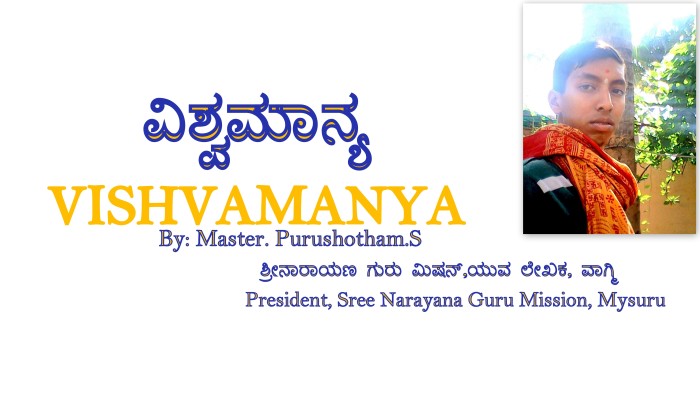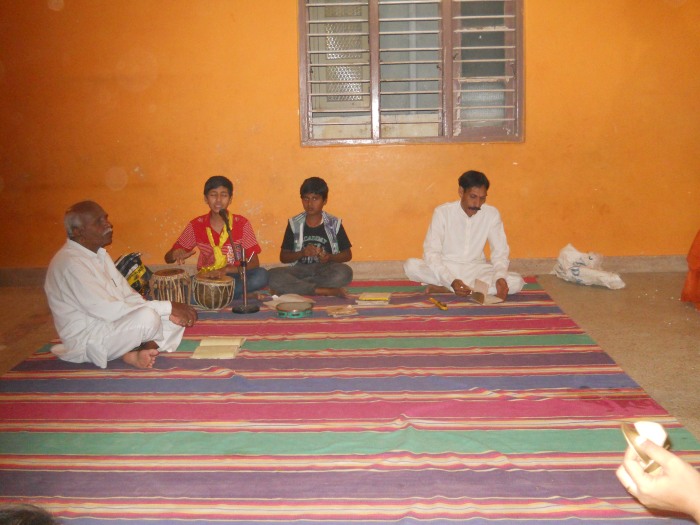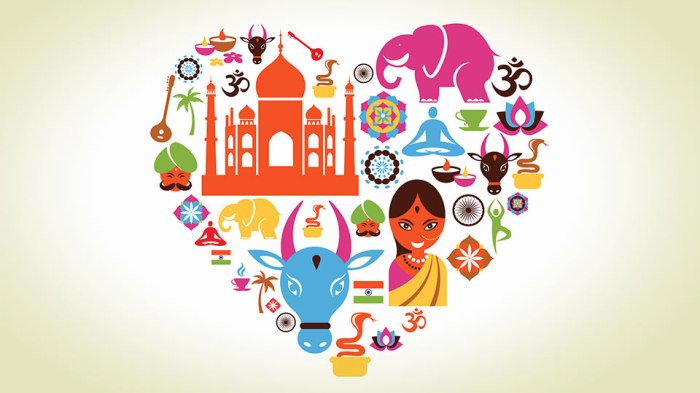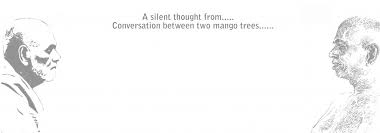Indian culture: A Great Guru 
Sree Narayana Guru: This spiritual ethos is not about belief systems. It is about systematic practices which sharpened the mind and body in a certain way. Wherever I travel, whatever kinds of groups of people I meet, I have spoken to top-level scientists, academics and students at very prestigious universities, and various other kinds of people, but I always find that the groups I meet in India are far sharper and smarter than most people anywhere in the world. The country is so effortlessly going ahead in the information technology age while everyone else is struggling essentially because the spiritual ethos in the culture has sharpened the intellect in a certain way. This ethos was so magnificently and intelligently presented in the past, but because of over two centuries of extreme poverty, it has gotten twisted out of shape over a period of time. Every generation has to twist it back into shape where it can be an effective tool for one’s liberation and wellbeing.
No other culture has looked at it as a science and created methods to evolve a person into his ultimate nature
Western societies talk about freedom and liberation in political systems. But liberation is the core value of who we are. The significance of this culture is that in every way, we created support for a human being to nurture himself towards his liberation because the only goal in this country was mukti. In the West, they may talk about freedom in physical and social atmospheres, but in terms of real life, there is no freedom because God will decide. Here, God does not decide anything. Here we say whatever is happening to you is your karma. That means it is your making. You are the maker of your life. This is constantly present in everything we do. Somewhere along the way because we lost battle after battle and were conquered, the same karma came to be perceived in a fatalistic negative way. Otherwise, when you say, “Your life is your karma,” we are saying your life is your making. No God is influencing you. And the ultimate goal, the core value of your life is freedom – freedom from prejudice, fear, death – everything.
If you want a family and work towards your liberation, you work that way. If you don’t need it, you work directly. But the only value once you are born in this culture is your mukti. That is how every aspect of this culture – even the simplest thing – was arranged. How should you be if you want to move towards your ultimate freedom?
Indian culture: Strategically designed
For example, people who come to our Sree Narayana Guru Mission for the first time notice the children sit on the floor. This is not to save furniture. Sitting cross-legged has immense benefits for your physiology and the development of your mind. Like this, every aspect of life was thought of very strategically.

This is the reason this culture must be nurtured – not because we are emotional about it but because it is a scientific process. It would take thousands of years to set up such a complex scientific mechanism that constantly drives you towards your liberation. Whether you sit, stand, or do anything else, it leads to your wellbeing. Music, dance – everything – is oriented towards making you free. People who get deeply involved in classical music or dance naturally turn spiritual. There is no other way to be.
Swami Vivekananda Note that: If we look at ourselves as a nation, the way people look, their language, food, way of dressing, music and dance, everything is different every 50 or 100 kilometers in the country. Everything about people who live in this country is different, but a cultural thread has held us together. This culture of what India has been, which cannot be quantified, is simply there. Wherever you go in the world, if you see an Indian, the very way he sits and walks, you know he is an Indian! It is extremely important that we strengthen this cultural thread because if you destroy this culture, there will be no spiritual process on the planet. There may be individual people in the rest of the world but culturally, there will be no spiritual process on the planet because this is not a culture that accidentally happened for convenience. This is a culture that was engineered by realized beings where every human being is working towards his ultimate liberation.
Indian culture: Engineered with gentleness
A certain gentleness was engineered into this culture by the enlightened ones of the past to ensure that its basic skeleton can never be misused in the name of the divine. Individual people may misuse so many things but it will never be empowered by divine sanction. Because of this, a certain gentleness flowered, but when this gentleness was treated as weakness by outside forces, the culture has paid a price and they were exploited.
Now that the world has moved on from military power to economic power, this is the time for this culture to manifest itself. A time has come to reinstate these cultural strengths. If the fundamental focus of this culture, which is to work towards liberating yourself from everything, is reinstated, and everyone strives for that, physically and intellectually, people can function effortlessly. Reestablishing that focus is most important today because every human being tends to get encumbered hugely by these things. But once a person is seeking his liberation and nothing else is important for him, he is greatly empowered.
Editor’s Note: Sadhguru’s of this BHARATA looks at the past, present and future of this nation, and explores why this culture matters to every human being on the planet. With images, graphics and Sadhguru’s inspiring words, here’s Bharat as you have never known it!
About Indian Culture analyzed of Sadguru’s Matters
In the following articles, Sadhus mixes wit and wisdom to present the historical context and current relevance of various aspects of Indian culture.
Indian culture is incredibly complex and resembles a chaos of mind-boggling proportions. But beneath this seeming chaos is a scientific foundation that is thousands of years old.
The caste system in India, as it appears today, looks unnecessary, unfair and uncalled for. Why should we discriminate between people on the basis of profession or birth? But this was not always the case. Sree Narayana Guru looks at why the caste system was setup in the first place and explores whether abolishing the caste system would solve any of the problems associated with it nowadays.
It has been a long-standing complaint that Indian youth are highly influenced by American and European cultures. With India fast becoming a truly global environment in terms of economy, food and culture, what does it take to make sure our youth do not forget the richness of being Indian?
Sacred Places
India is a land of temples. Sadhguru’s looks at how for millennia, temples have been instruments for raising human consciousness, and explores the science behind their creation.
Sree Narayana Gurudev describes the nature of consecration and what makes this life-transforming science so relevant to humanity.
His Holliness Sree Narayana Guru explores the nature of geometry and architecture, and explains the unique nature of the buildings at the Brahma Shree Narayana Guru Yoga Mandir, especially the Sree Narayana Gurudevan dome.
Idols are an integral part of worship in the Hindu way of life. Sadhguru looks at the how these are not mere depictions of gods, but are scientifically created as powerful energy centers.
Sadhguru explains the significance of the 12 Jyotirlingas and their importance as tools for our ultimate wellbeing.
We look at the significance of Kedarnath temple, one of the twelve Jyotirlingas, and how it has been a space energized by thousands of mystics and yogis over the ages.
We look at the legend of Badrinath temple and how Vishnu tricked Shiva and Parvati, and its history of how Adi Shankaracharya established the temple over a thousand years ago.
Sadhguru looks at how and why the Chidambaram temple was created and explores its association with Patanjali, the father of modern yoga.
Sadhguru speaks about Kailash, the great repository of mystical knowledge.
Kashi, or Varanasi as it is commonly known today, was the center of rituals, and a phenomenal tool created for spiritual growth. Sadhguru, looks at the lore and science behind some of its main rituals.
In India, most temples open to the general public are managed by priests not priestesses. Is this prejudice or is this science? Sadhguru answers.
The Science of Everyday Life
Have you ever scoffed at elders who told you not to sleep with your head placed to the north and other such things? Well, turns out they might just have had a point to make!
Sadhguru looks at the science of mudras and the capability of human hands to function as a “control panel to everything.”
The greeting of namaskar or namaste is an ubiquitous part of Indian culture. Sadhguru ‘s explains the science and significance behind the gesture of joining our palms together.
Skeptics say no, believers say yes, but does astrology work? Sages, looks at Vedic astrology and whether the stars and planets can influence our lives.
We look at the science and impact of Indian classical music, as Sadhguru’s interacts with , doyen of Hindustani classical music
There is a lot more to the humble oil lamp, as Sadhguru’s tells us, than its obvious use of providing light and aesthetics. Find out more about how you can create an ambience of energy and positivity in your home.
Bha-ra-ta!
Sadhguru and Kiran Bedi explore the meaning of the name “Bharat”, and how it wasn’t just a name inherited from India’s first emperor, but a scientific device to find your rhythm with the tune of existence.
Sadhguru and Kiran Bedi continue their discussion of what makes a nation successful, and what it will take to bring Bharat back to its past glory.
Sadhguru pens a poem on this ancient nation, which is a “nation of seekers, seeking not wealth or wellbeing, but liberation.”
2G, Coalgate, IPL and so on are familiar acronyms for various scandals of thepast few years. Sadhguru looks at what is needed to root out corruption in India.
Mystic India
Sadhguru speaks about the science behind the system of gotras and kulas that were established in Indian culture, which show a deep understanding of genetics.
Brahmacharya has always been an integral part of the spiritual process. Sadhguru speaks about what brahmacharya is, and who a brahmachari is.
Sadhguru looks at the science and significance behind the Kumbha Mela, the greatest gathering of people in the world.
Vibhuti, the sacred ash, is a very important of the spiritual seeker’s life. Sadhguru looks at the methods of preparing vibhuti, how it should be used and where it must be applied on the body.
A rudraksha is the seed of the Eliocarpus ganitrus tree and plays an important role in a spiritual seeker’s life. Sadhguru looks at the various types of these beads and their benefits, including the panchmukhi and ek mukhi.
Sadhguru talks about the connection between mysticism and snakes, and the power and energy of this mysterious creature.
Sadhguru answers a question on the difference between sadhus, saints, seers, and yogis, and where enlightenment fits into all this.
Sadhguru explains the science of the four yugas, and calculates the timeline of Kali Yuga and the coming shift in human consciousness in 70 years.
Festivals in Indian Culture
Festivals are a very significant part of Indian culture. Sadhguru explains how celebration can be a passageway to the most profound aspects of life.
We look at the significance of the Makar Sankranti festival, a day where there is a significant movement in the zodiac – the arrangement of the earth’s dial around the sun.
Sadhguru looks at the significance of Pongal, celebrated in the month of Thai in the Tamil Calendar.
Mahashivarathri is the most significant festival in India. Sadhguru explains why, and looks at how it can be a stepping stone in spiritual evolution.
Sadhguru speaks of the importance of the Tamil New Year festival in helping us stay connected to the food we eat and the Earth from which we have all sprung.
Sadhguru gives us a special Ugadi message, revealing the science behind why today is the new year.
Sadhguru looks at why Rama is worshipped throughout India, and what we can imbibe from his life.
The full moon day in the month of Ashadha (June-July) is known as Guru Purnima. This sacred day falls on July 12 in 2014, and honors the ancient lineage of enlightened beings.
Sadhguru explains the significance of Mahalaya Amavasya or Pitru Paksha, and why the tradition of honoring our ancestors is significant.
Dussehra or Vijayadashami is the tenth day that follows the nine days of Navratri. Sadhguru explains how it can bring success and victory into our life.
Sadhguru explains how Ayudha Pooja can be an important tool for growth, and much more than just a ritual.
Sadhguru looks at the legend behind Naraka Chaturdashi, when Krishna slew the demon Naraka, and explains how it is still relevant to us today.
Sadhguru explains the significance of the Festival of Lights – Diwali, and how we can make it a cracker of a time!
Sadhguru explains the importance of the Kartik month and looks at why lighting lamps is so significant in this month.
*****VISHVAMANYA******











